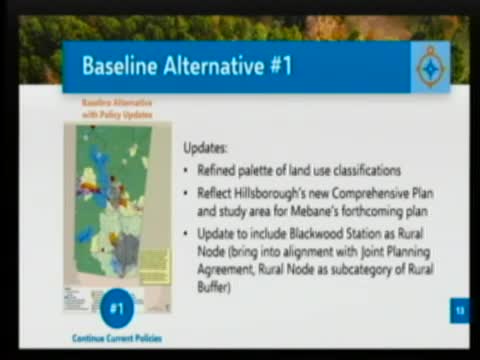Orange County considers drastic changes to housing policies
September 10, 2024 | Orange County, North Carolina
This article was created by AI summarizing key points discussed. AI makes mistakes, so for full details and context, please refer to the video of the full meeting. Please report any errors so we can fix them. Report an error »

In a recent government meeting, officials discussed updates to land use policies in unincorporated Orange County, focusing on the inclusion of Blackwood Station as a designated rural node. This adjustment aligns with a joint planning agreement aimed at maintaining current land use densities while exploring alternatives for future development.
The meeting highlighted two primary alternatives for land use management. The first alternative emphasizes conservation, proposing to lower residential densities across most unincorporated areas, with exceptions for urbanizing and lower-density residential zones. This approach aims to protect priority agricultural, environmental, and watershed lands, potentially limiting new housing opportunities and raising concerns about affordability for lower-income residents.
Officials acknowledged the implications of such density reductions, with one member expressing strong opposition to limiting housing development, citing past community backlash. The discussion underscored the need for transparency regarding the trade-offs involved in these policy options, particularly in light of community feedback favoring open space preservation.
The second alternative presented involved the concept of rural conservation neighborhoods, which would allow for more dense housing developments while mandating that 60% of the site be preserved as open space. This model aims to balance development with environmental protection and could facilitate mixed-use centers that support local employment.
The meeting also touched on the necessity of explicit policies to support community water and wastewater systems for new developments, as current reliance on individual wells and septic systems may not suffice for more intensive land use. Officials clarified that while community systems are permitted, there is a need for public education on their feasibility and implementation.
Overall, the discussions reflect a careful consideration of land use strategies that prioritize environmental conservation while addressing the community's housing needs. The outcomes of these deliberations will be crucial as the county navigates the complexities of growth and sustainability in the coming years.
The meeting highlighted two primary alternatives for land use management. The first alternative emphasizes conservation, proposing to lower residential densities across most unincorporated areas, with exceptions for urbanizing and lower-density residential zones. This approach aims to protect priority agricultural, environmental, and watershed lands, potentially limiting new housing opportunities and raising concerns about affordability for lower-income residents.
Officials acknowledged the implications of such density reductions, with one member expressing strong opposition to limiting housing development, citing past community backlash. The discussion underscored the need for transparency regarding the trade-offs involved in these policy options, particularly in light of community feedback favoring open space preservation.
The second alternative presented involved the concept of rural conservation neighborhoods, which would allow for more dense housing developments while mandating that 60% of the site be preserved as open space. This model aims to balance development with environmental protection and could facilitate mixed-use centers that support local employment.
The meeting also touched on the necessity of explicit policies to support community water and wastewater systems for new developments, as current reliance on individual wells and septic systems may not suffice for more intensive land use. Officials clarified that while community systems are permitted, there is a need for public education on their feasibility and implementation.
Overall, the discussions reflect a careful consideration of land use strategies that prioritize environmental conservation while addressing the community's housing needs. The outcomes of these deliberations will be crucial as the county navigates the complexities of growth and sustainability in the coming years.
View full meeting
This article is based on a recent meeting—watch the full video and explore the complete transcript for deeper insights into the discussion.
View full meeting
